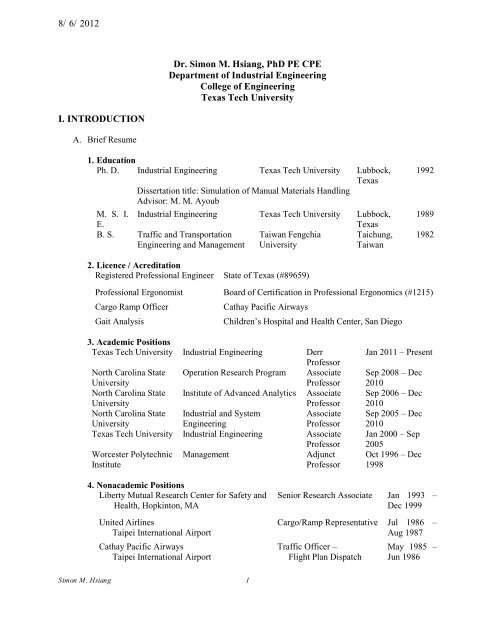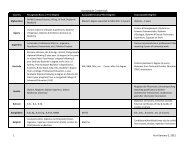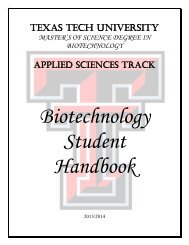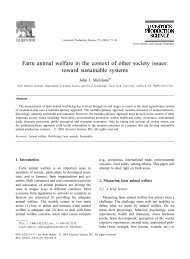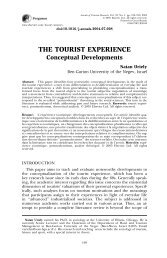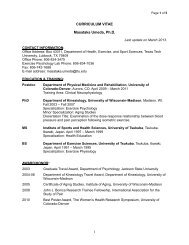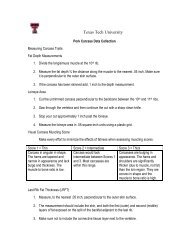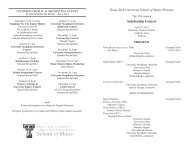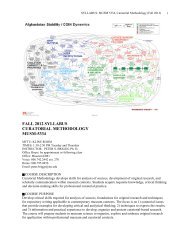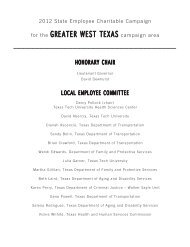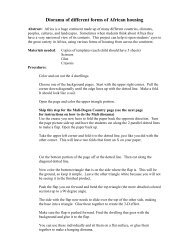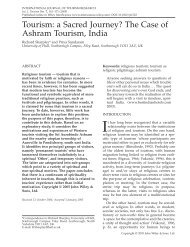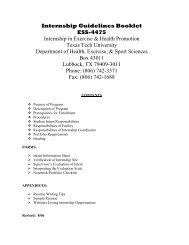Curriculum Vitae - Texas Tech University
Curriculum Vitae - Texas Tech University
Curriculum Vitae - Texas Tech University
Create successful ePaper yourself
Turn your PDF publications into a flip-book with our unique Google optimized e-Paper software.
8/ 6/ 2012<br />
Dr. Simon M. Hsiang, PhD PE CPE<br />
Department of Industrial Engineering<br />
College of Engineering<br />
<strong>Texas</strong> <strong>Tech</strong> <strong>University</strong><br />
I. INTRODUCTION<br />
A. Brief Resume<br />
1. Education<br />
Ph. D. Industrial Engineering <strong>Texas</strong> <strong>Tech</strong> <strong>University</strong> Lubbock,<br />
<strong>Texas</strong><br />
Dissertation title: Simulation of Manual Materials Handling<br />
Advisor: M. M. Ayoub<br />
M. S. I.<br />
E.<br />
Industrial Engineering <strong>Texas</strong> <strong>Tech</strong> <strong>University</strong> Lubbock,<br />
<strong>Texas</strong><br />
B. S. Traffic and Transportation Taiwan Fengchia Taichung,<br />
Engineering and Management <strong>University</strong><br />
Taiwan<br />
1992<br />
1989<br />
1982<br />
2. Licence / Acreditation<br />
Registered Professional Engineer State of <strong>Texas</strong> (#89659)<br />
Professional Ergonomist Board of Certification in Professional Ergonomics (#1215)<br />
Cargo Ramp Officer<br />
Gait Analysis<br />
Cathay Pacific Airways<br />
Children’s Hospital and Health Center, San Diego<br />
3. Academic Positions<br />
<strong>Texas</strong> <strong>Tech</strong> <strong>University</strong> Industrial Engineering Derr<br />
Professor<br />
North Carolina State Operation Research Program Associate<br />
<strong>University</strong><br />
Professor<br />
North Carolina State Institute of Advanced Analytics Associate<br />
<strong>University</strong><br />
Professor<br />
North Carolina State Industrial and System<br />
Associate<br />
<strong>University</strong><br />
Engineering<br />
Professor<br />
<strong>Texas</strong> <strong>Tech</strong> <strong>University</strong> Industrial Engineering Associate<br />
Worcester Polytechnic<br />
Institute<br />
Management<br />
Professor<br />
Adjunct<br />
Professor<br />
Jan 2011 – Present<br />
Sep 2008 – Dec<br />
2010<br />
Sep 2006 – Dec<br />
2010<br />
Sep 2005 – Dec<br />
2010<br />
Jan 2000 – Sep<br />
2005<br />
Oct 1996 – Dec<br />
1998<br />
4. Nonacademic Positions<br />
Liberty Mutual Research Center for Safety and<br />
Health, Hopkinton, MA<br />
United Airlines<br />
Taipei International Airport<br />
Cathay Pacific Airways<br />
Taipei International Airport<br />
Senior Research Associate Jan 1993 –<br />
Dec 1999<br />
Cargo/Ramp Representative Jul 1986 –<br />
Aug 1987<br />
Traffic Officer –<br />
Flight Plan Dispatch<br />
May 1985 –<br />
Jun 1986<br />
Simon M. Hsiang 1
8/ 6/ 2012<br />
Logistic Command<br />
ROC Air Force (Taiwan)<br />
Second Lieutenant –<br />
Safety Security officer<br />
May 1982 –<br />
Apr 1984<br />
5. Fields Of Specialization<br />
Human Factors/Ergonomics<br />
1. Cognitive Engineering – perceptual models, psychophysics, information theory,<br />
crossover model, optimal control.<br />
2. Occupational Biomechanics – bioinstrumentation, signal processing, digital human<br />
simulation, disc disruption theory, gait analysis.<br />
3. Virtual Reality – signal detection, optic flows manipulation, haptic feedback, Kalman<br />
filter.<br />
Modeling and System Design<br />
1. Data Mining – cluster analysis, multiple scaling, principle components, factor analysis,<br />
discriminant analysis, fuzzy neural network, multidimensional scaling, nonlinear<br />
regression.<br />
2. System Identification – ARX, ARMAX, state-space models.<br />
3. Human Safety and Reliability – axiomatic design, accelerated life testing, survival/failure<br />
analysis, proportional hazardous model, risk analysis.<br />
6. Professional Activities<br />
Professional Societies<br />
1. Human Factors and Ergonomics Society (HFES)<br />
2. Institute of Electrical and Electronics Engineers, Inc. (IEEE)<br />
3. Society of Automotive Engineers (SAE)<br />
4. American Institute of Aeronautics and Astronautics (AIAA)<br />
5. Alpha Pi Mu<br />
Editorial Activities<br />
1. Editorial Board for Theoretical Issues in Ergonomics Science<br />
2. Editorial Board for International Journal for Applied Industrial Engineering<br />
3. Editorial Board for Human Factors and Ergonomics in Manufacturing & Service<br />
Industries<br />
4. Referee for Journal of Cognitive Engineering & Decision Making<br />
5. Referee for IEEE Transaction IEEE Transactions on Systems, Man, and Cybernetics<br />
6. Referee for IEEE Transactions on Industrial Informatics<br />
7. Referee for Computers & Industrial Engineering<br />
8. Referee for International Journal of Industrial Ergonomics<br />
9. Referee for Journal of Electromyography & Kinesiology<br />
10. Referee for Journal of Biomechanics<br />
11. Referee for Applied Ergonomics<br />
12. Referee for Ergonomics<br />
13. Referee for Clinical Biomechanics<br />
14. Referee for Theoretical Issues in Ergonomics Science<br />
Simon M. Hsiang 2
8/ 6/ 2012<br />
15. Referee for Gait and Posture<br />
16. Referee for Safety Science<br />
17. Referee for McGraw-Hill<br />
18. Referee for John Wiley & Sons<br />
19. Referee for CRC Press<br />
Conference Organization<br />
1. <strong>Tech</strong>nical Program Committee, IEEE Three-Rivers Workshop on Soft Computing in<br />
Industrial Applications, 2007<br />
2. International Program Committee, IEEE Systems, Man, and Cybernetics Society,<br />
Industrial Applications TC, 2006<br />
3. Program Committee, Biomechanical Simulation, International Society of Biomechanics<br />
<strong>Tech</strong>nical Group, Tokyo, 2005<br />
8. Professional service on campus:<br />
NCSU<br />
1. Member Institutional Review Board for the Use of Human Subjects in Research (Current)<br />
2. College of Engineering Open House (Current)<br />
3. Graduate Admissions Committee (Current)<br />
4. Department Faculty Search Committee (Current)<br />
<strong>Texas</strong> <strong>Tech</strong><br />
1. Senator, <strong>Texas</strong> <strong>Tech</strong> Faculty Senate, 2001 – 2005<br />
2. Member, Chairman Search Committee, Department of Industrial Engineering, <strong>Texas</strong><br />
<strong>Tech</strong> <strong>University</strong> 2001<br />
3. Member, Member, Faculty Search Committee, Department of Industrial Engineering,<br />
<strong>Texas</strong> <strong>Tech</strong> <strong>University</strong> 2001 – 2002<br />
4. Advisor, Speed-Accuracy Tradeoff due to the Mechanical Advantage of a Manipulator,<br />
2001 Reduced-Gravity Program, NASA, Lyndon B. Program Johnson Space Center<br />
(JSC)<br />
5. Advisor, Robust Orthotics Impedance for Speed-Accuracy Tradeoff, 2003 Reduced-<br />
Gravity Program, NASA, Lyndon B. Program Johnson Space Center (JSC)<br />
II. TEACHING AND MENTORING OF UNDERGRADATE AND GRADUATE<br />
STUDENTS<br />
Courses Taught<br />
North Carolina State <strong>University</strong><br />
IE 712 Bayesian Decision Analysis for Engineers and Managers – The Bayesian approach to<br />
decision making, with numerous applications in engineering and business. Expected value<br />
maximization, decision trees, Bayes' theorem, value of information, sequential procedures,<br />
Bayesian networks and optimal strategies. Axiomatic utility theory and controversies, utility<br />
of money, theoretical and empirical determination of utility functions and relationship to<br />
mean-variance analysis. Brief introduction to multi-attribute problems, time streams and<br />
group decisions.<br />
Simon M. Hsiang 3
8/ 6/ 2012<br />
IE 794 IE 794 Risk Analysis – Students learn how to construct an alternative decision, construct a<br />
survey, identify and manage bias, identify and select alternatives, and implement the chosen<br />
outcome. This course explores the use of proven techniques for reliability engineering<br />
models, survival data analysis and test planning (i. e., censor), enhanced and brought up to<br />
date with modern data-based graphical, analytical and diagnostic tools. This course is<br />
designed to extend the important decision models from mono-criterion to a more humanistic<br />
multi-criterion framework.<br />
IE544 Occupational Biomechanics (Similar to <strong>Texas</strong> <strong>Tech</strong> IE5304)<br />
IE452 Ergonomics (Similar to <strong>Texas</strong> <strong>Tech</strong> IE5301)<br />
NCSU Advanced Analytics – Data Mining I – This module explores the mutual (reciprocal)<br />
influences between data mining and the human decision-making process. The supporting<br />
information from data mining that allows the decision maker to assign probabilities to those<br />
outcomes with various utility.<br />
NCSU Advanced Analytics – Survival Analysis – This module explores the use of proven<br />
traditional techniques for survival data analysis (e. g., proportional hazards) and test planning,<br />
enhanced and brought up to date with modern data-based graphical, analytical and diagnostic<br />
tools, including case-based fault diagnoses and model-based fault diagnoses.<br />
<strong>Texas</strong> <strong>Tech</strong> <strong>University</strong><br />
IE4361 Engineering Design for People – This course emphasizes the design of systems for<br />
human use. It includes instruction on human sensory and information processing abilities,<br />
human-machine system design processes and principles, and the reduction of human error in<br />
systems design.<br />
IE4362 Industrial Ergonomics – This course explains advanced ergonomics principles with an<br />
emphasis on the physiological, biomechanical, and psychological assessment of work. The<br />
course also covers the subject of human capabilities and limitations.<br />
IE5301 Ergonomics and Design – This course studies the functional anatomy and physiology of<br />
the musculoskeletal system and their applications in work design. Additionally, this course<br />
introduces the topics of work physiology, kinesiology, and anthropometry and their<br />
applications. Consent of the instructor is prerequisite to this course.<br />
IE5304 Occupational Biomechanics – This course covers the following topics in occupational<br />
biomechanics: the historical development and theoretical fundamentals of body mechanics,<br />
the body link system and kinematic and kinetic aspects of body movement, and application<br />
of biomechanics to work systems.<br />
IE5305 Cognitive Engineering – studies the implications of human perceptual, cognitive, and<br />
psycho-motor capabilities for the design of systems for effective human use and control.<br />
IE5309 Human Factors in Engineering and Design – This course introduces human factors<br />
issues in the design of human-machine systems, including the design of workstations,<br />
controls and displays, human-computer interfaces, and the environment in industrial<br />
systems.<br />
IE5342 Design of Experiments – This course covers the following topics: single factor,<br />
factorial, blocked, and spit plot designs., means comparisons, contrasts, and estimates of<br />
variation., and confounding and fractional factorials.<br />
IE5344 Statistical Data Analysis – This course covers the following topics: exploratory data<br />
analysis and graphical displays and analysis., linear and nonlinear regression and response<br />
surfaces., and selected mainframe and microcomputer packages.<br />
Simon M. Hsiang 4
8/ 6/ 2012<br />
Worcester Polytechnic Institute (WPI)<br />
IE3760 Simulation Modeling and Analysis – This course covers the application of simulation to a<br />
variety of managerial problems with examples from operations management, industrial<br />
engineering and manufacturing engineering.<br />
IE3450 Human Factors Engineering – This course examines the human-machine interface in the<br />
workplace, concentrating on how workplace design can influence effectiveness and enhance<br />
health, safety, and satisfaction.<br />
Harvard School of Public Health (guest lecturer)<br />
EH243 Ergonomics and Human Factors – A hour survey of ergonomics and human factors with<br />
applications of epidemiology, cost and risk factors for work-related musculoskeletal<br />
disorders.<br />
NIOSH Training Grant Master Program Advisor (10 MS students)<br />
Senior Project Advisor (12 BS students)<br />
Student Advising Activities and Responsibilities<br />
PhD Dissertation<br />
1. Wambeke, B, W.”Identifying, Prioritizing, and Reducing Variation of Construction Related<br />
Tasks” 2011 (US Army Academy at West Point, accepted)<br />
2. Hong, T “Long-Term Spatial Load Forecasting Using Human Machine Co-construct Intelligence<br />
Framework”. August 2010<br />
3. Kim, S. Y.”Co-construct Intelligence for Human-Machine Interaction” August 2010<br />
4. Wang, X-Z.”Application of Deterministic and Stochastic Components of the Ocular Dynamic<br />
System.” August 2010.<br />
5. Brewer, J. D., “Effects of Running with Backpack Loads during Simulated Gravitational<br />
Transitions—Improvements in Postural Control.” December 2003. (Currently at Sandia National<br />
Laboratory)<br />
6. Chang., C. C., “Biomechanical simulation of manual lifting using space-time optimization” May<br />
1996. (Currently at Liberty Mutual Research Institute of Safety and Health)<br />
7. Dong, H.”System Identification of Gait under Micro-G Environment” Expected graduation: May<br />
2006. (West <strong>Texas</strong> Oil and Gas Eq. Inc. )<br />
8. Ladavichitkul, P.”Simulation of Tossing in Manual Materials Handlings” (Dec 2008) (Currently<br />
Chulalongkorn <strong>University</strong>, Bangkok)<br />
9. Park, W. H., “Anticipation and Adaptation in Gait Control.” May 2004 (Currently at <strong>University</strong><br />
of Montana)<br />
10. Sheiknainar, M.”Situation Awareness In Virtual Reality Locomotion” (Co-chair with Kaber) May<br />
2007<br />
Simon M. Hsiang 5
8/ 6/ 2012<br />
11. Xu, X. An Investigation on the Interactivity between Suspended-load Backpack and Human Gait,<br />
April 2008 (Currently at Liberty Mutual Research Institute of Safety and Health)<br />
12. Zhang, Y-X., “Development of Methodology in Biomechanical Simulation of Manual Lifting.”<br />
Expected graduation: May 2005. (Currently at <strong>University</strong> of Western Australia)<br />
Doctoral Students Currently Mentoring<br />
1. Chen, Y. M.”Copula Model for Risk Assessment” (QE)<br />
2. Lee, J. Y.”Hierarchical Dirichlet Process for Risk Evaluation” (QE)<br />
3. Sittivijan, P.”Risk Trade-off Using Choquet Integral for Health Care Management” (Thailand<br />
Government Health Care Fellowship)<br />
Master Students Currently Mentoring<br />
1. Yu, F.”Machina Triangle for Risk Assessment”<br />
2. Wang, C.”Activity Scheduling and Simulation for a Concrete Slab Plant”<br />
3. Hajifathalian, K.”Mean Variance Analysis for a Parade Game Simulation”<br />
Doctoral Dissertation Committee<br />
1. Li, L.”A Two-person Investment Game.” 2010<br />
2. Li, P. K.”Fuzzy Relational Equations: Resolution and Optimization” 2009<br />
3. Zhang, T.”Using Measures of Situation Awareness to Characterize Mental Models in Inductive<br />
Reasoning Tasks” 2009<br />
4. Lightner, C. A “A Tabu Search Approach To Multiple Sequence Alignment” 2008<br />
5. Shu, Y.”Biomechanical Analysis of Eccentric and Concentric Lifting Exertions.” 2007<br />
6. Jiang, ZL. Application of an Entropy-Assisted Optimization Model in Prediction of Agonist and<br />
Antagonist Muscle Forces. 2007<br />
7. Pacheco, L., “System Performance in Aviation.” 2005.<br />
8. Li, J., “A Multi-Agent Negotiation Based Decision Framework for Extensible Framework Life<br />
Cycle.” December, 2003.<br />
9. Samir, M. T., “Improving Wafer Temperature Uniformity for Etch Applications.” 2003<br />
10. T. -H. Jang, “Stochastic Finite Element <strong>Tech</strong>nique for Cervical Spine Analysis” 2002<br />
11. J. Sun, “Probabilistic Optimization of a Structure for Crashworthiness” 2001<br />
Simon M. Hsiang 6
8/ 6/ 2012<br />
Master’s Thesis Committee<br />
1. Karabelchtchikova, O.”Modeling of Multipass Grinding Effect on Residual Stresses Distribution<br />
and Surface Integrity of D2 Thread Rolling Dies” May, 2004.<br />
2. Kamm, G. C.”Novel Apparatus for Evaluation of Head and Neck Injury,” May 2003.<br />
3. H. Zhao, “Energy Absorption of Reinforced Thin Tubes,” May 2001.<br />
4. Davis. A. S.”The Sensitivity Of Sampling Inspection To Inspector Error” 2005<br />
5. Hastings D. R.”An Investigation Of The Effect Of Work Surface Height And Operator Size On<br />
Physiological Cost In An Assembly Operation” 2002<br />
6. McElhannon, B. V.”An Analysis Of The Center Of Gravity Of The Arm During Certain<br />
Simulated Industrial Moves” 2000<br />
7. Raheja, B. G.”Effect Of Pace On Velocity and Acceleration Patterns Of Body Member Motions<br />
in Space” 2001<br />
III. RESEARCH ACTIVITIES<br />
Journal Publication<br />
1. Uy, C., Chang, C-C., Fallentin, N., Hsiang, S. M. (Pending) “The Effect of Handle Design on<br />
Upper Extremity Posture and Muscle Activity during a Pouring Task” Applied Ergonomics<br />
2. Hajifathalian, K., Wambeke, B., Liu, M., Hsiang, S. M. (2012) “Effects of production control<br />
strategy and duration variance on productivity and work in process ‐ a simulation‐based<br />
investigation.” accepted by ASCE Journal of Construction Engineering and Management<br />
3. Wang, C., Liu, M., Hsiang, S. M., Leming, M. L.”Causes and Penalties of Variation: Case Study<br />
of a Precast Concrete Slab Production Facility” ASCE Journal of Construction Engineering and<br />
Management, Vol 138, No 6, pp 775-785.<br />
4. Wambeke, B. R. ., Liu, M. and Hsiang, S. M., (2012) “Using Last Planner® and a Risk<br />
Assessment Matrix to Reduce Variation in Mechanical Related Construction Tasks.” ASCE<br />
Journal of Construction Engineering and Management, Vol 138, No 4, pp 491-498.<br />
5. Wambeke, B. R. ., Hsiang, S. M. and Liu, M., (2011) “Causes of Variation in Construction<br />
Project Task Starting Times and Duration.” ASCE Journal of Construction Engineering and<br />
Management, Vol 137, No 9, pp 663-677.<br />
6. Wambeke, B. R. ., Liu, M. and Hsiang, S. M., (Pending) “Using Pajek and Centrality Analysis to<br />
Identify a Social Network of Construction Trades.” ASCE Journal of Construction Engineering<br />
and Management.<br />
7. Wang, X., and Hsiang, S. M. (Pending) “Gaze Control for Human Computer Interaction with<br />
Hot-Zone and Gaze Pattern Recognition.” IEEE Transactions on Systems Man and Cybernetics<br />
Part A.<br />
8. Wang, X. Z. and Hsiang, S. M. (2011) “Modeling Trade-Off between Time-Optimal and<br />
Minimum Energy in Saccade Main Sequence.” Biological Cybernetics, Vol 104, No 1-2, pp 65-<br />
73<br />
Simon M. Hsiang 7
8/ 6/ 2012<br />
9. Coker, P., Karakostas, T., Dodds, C, and Hsiang, S. (2010) “Gait Characteristics of Children with<br />
Hemiplegic Cerebral Palsy before and after Modified Constraint-Induced Movement Therapy.”<br />
Disability and Rehabilitation, Vol 32, No 5, pp 402-408<br />
10. Chang, C. C., McGorry, R. W., Lin, J-. H., Xu, X., Hsiang, S. M. (2010) “Prediction Accuracy nn<br />
Estimating Joint Angle Trajectories Using a Video Posture Coding Method for Sagittal Lifting<br />
Tasks.” Ergonomics, Vol 53, No 8, pp 1039-1047<br />
11. Zhang, T., Kaber, D. and Hsiang, S. M. (2010) “Characterisation of Mental Models in a Virtual<br />
Reality-Based Multitasking Scenario Using Measures of Situation Awareness.” Theoretical Issues<br />
in Ergonomics Science, Vol 11, No 1, pp 99-118.<br />
12. Karabelchtchikova, O, Hsiang S. M., Sisson, R. D. (2009) “Multi-objective Optimisation of Gas<br />
Carburising Process in Batch Furnaces with Endothermic Carburising Atmosphere.” Surface<br />
Engineering, Vol 25, No 1, pp 43-49.<br />
13. Dong, H. N., Hsiang, S. M., Smith, J. L. (2009) “An Optimal-Control Model of Vision-Gait<br />
Interaction in a Virtual Walkway.” IEEE Transactions on Systems Man And Cybernetics Part B-<br />
Cybernetics, Vol 39, No 1, pp 156-166<br />
14. Xu, X., Hsiang, S. M., Mirka, G. A. (2009) “The Effects of a Suspended-Load Backpack on Gait”<br />
Gait and Posture, Vol 29, No 1, pp 151-153.<br />
15. Rivero, I. V., Pantoya, M. L., Rajamani, K., Hsiang, S. M. (2009) “Correlation of Reactant<br />
Particle Size on Residual Stresses of Nanostructured Nial Generated by Self-Propagating High-<br />
Temperature Synthesis.” Journal of Materials Research, Vol 24, June, pp 2079-2088.<br />
16. Xu, X,, Hsiang, S. M., and. Mirka, G. (2008) “Coordination Indices between Lifting Kinematics<br />
and Kinetics” International Journal of Industrial Ergonomics, Vol 38, No11-12, pp 1062-1066<br />
17. Kaber, D. B., Alexander, A. L., Stelzer, E. M., Hsiang, S. M. (2008) “Perceived Clutter in<br />
Advanced Cockpit Displays: Measurement and Modeling with Experienced Pilots.” Aviation<br />
Space and Environmental Medicine, Vol 79, No 11, pp 1007-1018.<br />
18. Zhang, Y. and Hsiang, S. M. (2008) “Simulation of Manual Material Handling Tasks in Three<br />
Dimensional Spaces.” International Journal of Human Factors Modeling and Simulation, Vol 1,<br />
No 2, pp197-210<br />
19. Karabelchtchikova, O., Rivero, IV., and Hsiang, S. M. (2008) “Modeling of Residual Stress<br />
Distribution in D2 Steel via Grinding Dynamics Using a Second-Order Damping System” Journal<br />
of Materials Processing <strong>Tech</strong>nology. Vol 198, No 1-3, pp 313-322<br />
20. Xu X, Mirka GA, Hsiang S. M. (2008) “The Effects of Obesity on Lifting Performance.” Applied<br />
Ergonomics, Vol 39, No 1, pp 93-98<br />
21. Hsiang, S. M., Ekwaro-Osire, Jang T. H. (2007) “Designing against Head Injury while<br />
Considering Neck Injury.” Journal of Integrated Design and Process Science, Vol 11, No 1, pp<br />
41-59.<br />
22. Karakostas T., Hsiang S. M, Sarantopoulos C, Krause J. (2007) “Dynamic Loading Performance<br />
of Fasciocutaneous Flaps and Implications for Gait.” Clinical Biomechanics (Bristol, Avon). Vol<br />
22, No 4, pp 478-485<br />
Simon M. Hsiang 8
8/ 6/ 2012<br />
23. Hsiang, S. M., Dong H. and Karakostas, T. (2006) “Optimal Control in Virtual Walkway.” IEEE<br />
Mountain Workshop on Adaptive and Learning Systems, SMCals, pp 104-109.<br />
24. Chang, C. C., S. Hsiang, P. G. Dempsey and R. W. McGorry (2003) “A Computerized Video<br />
Coding System for Biomechanical Analysis of Lifting Tasks.” International Journal of Industrial<br />
Ergonomics, Vol 32, No 4, pp 239-250.<br />
25. Brewer, J. D. and S. M. Hsiang (2002) “The 'Ergonomics Paradigm': Foundations, Challenges<br />
and Future Directions.” Theoretical Issues in Ergonomics Science, Vol 3, No 3, pp 285-305.<br />
26. Hsiang, S. M. and C. C. Chang (2002) “The Effect of Gait Speed And Load Carrying on the<br />
Reliability of Ground Reaction Forces.” Safety Science, Vol 40, No 7-8, pp 639-657.<br />
27. McGorry, R. W., S. M. Hsiang, F. A. Fathallah and E. A. Clancy (2001) “Timing of Activation of<br />
The Erector Spinae and Hamstrings During a Trunk Flexion and Extension Task.” Spine, Vol 26,<br />
No 4, pp 418-25.<br />
28. Chang, C. C., D. R. Brown, D. S. Bloswick and S. M. Hsiang (2001) “Biomechanical Simulation<br />
of Manual Lifting Using Spacetime Optimization.” Journal of Biomechanics, Vol 34, No 4, pp<br />
527-532.<br />
29. Gronqvist, R., J. Abeysekera, G. Gard, S. M. Hsiang, T. B. Leamon, D. J. Newman, K. Gielo-<br />
Perczak, T. E. Lockhart and C. Y. C. Pai (2001) “Human-centred Approaches in Slipperiness<br />
Measurement.” Ergonomics Vol 44, No 13, pp 1167-1199.<br />
30. McGorry, R. W., B. S. Webster, S. H. Snook and S. M. Hsiang (2000).”The Relation between<br />
Pain Intensity, Disability, and the Episodic Nature of Chronic and Recurrent Low Back Pain.”<br />
Spine, Vol 25, No 7, pp 834-41.<br />
31. McGorry, R. W. and S. M. Hsiang (2000) “A Method for Dynamic Measurement of Lumbar<br />
Lordosis.” Journal of Spinal Disorders & <strong>Tech</strong>niques, Vol 13, No 2, pp 118-123.<br />
32. McGorry, R. W., B. S. Webster, S. H. Snook and S. M. Hsiang (1999) “Accuracy of Pain Recall<br />
in Chronic and Recurrent Low Back Pain.” Journal of Occupational Rehabilitation, Vol 9, No 3,<br />
pp 169-178.<br />
33. Hsiang, S. M., C. C. Chang and R. W. McGorry (1999) “Development of a Set of Equations<br />
Describing Joint Trajectories during Para-Sagittal Lifting.” Journal of Biomechanics, Vol 32, No<br />
8, pp 871-876.<br />
34. McGorry, R. W. and S. M. Hsiang (1999) “The Effect of Industrial Back Belts and Breathing<br />
<strong>Tech</strong>nique on Trunk and Pelvic Coordination during a Lifting Task.” Spine, Vol 24, No 11, pp<br />
1124-1130.<br />
35. Hsiang, S. M. and R. W. McGorry (1999).”The Role of the Intra-Abdominal Pressure and Back<br />
Belts During Lifting.” Journal of Ergonomic Study, Vol 1, No 1, pp 21-38.<br />
36. McGorry, R. W., S. M. Hsiang, S. H. Snook, E. A. Clancy and S. L. Young<br />
(1998).”Meteorological Conditions and Self-Report of Low Back Pain.” Spine, Vol 23, No 19, pp<br />
2096-2102., discussion 2103.<br />
37. Hsiang, S. M., G. E. Brogmus, S. E. Martin and I. B. Bezverkhny (1998).”Video based Lifting<br />
<strong>Tech</strong>nique Coding System.” Ergonomics, Vol 41, No 3, pp 239-256.<br />
Simon M. Hsiang 9
8/ 6/ 2012<br />
38. Hsiang, S. M., P. X. Jiang and R. W. McGorry (1998). “Load Carrying, Gait and<br />
Stability. Advances in Occupational Ergonomics and Safety.” Vol 2, No 2, pp 260-263.<br />
39. Hsiang, S., R. McGorry and I. Bezverkhny (1997).”The Use of Taguchi's Methods for the<br />
Evaluation of Industrial Knife Design.” Ergonomics, Vol 40, No 4, pp 476-490.<br />
40. Hsiang, S. M., G. E. Brogmus and T. K. Courtney (1997).”Low Back Pain (LBP) and Lifting<br />
<strong>Tech</strong>nique - a Review.” International Journal of Industrial Ergonomics, Vol 19, No 1, pp 59-74.<br />
41. Hsiang, S. M. and R. W. McGorry (1997).”Three Different Lifting Strategies for Controlling the<br />
Motion Patterns of the External Load.” Ergonomics Vol 40, No 9, pp 928-939.<br />
42. Hsiang, S. H. and M. M. Ayoub (1994).”Development of Methodology in Biomechanical<br />
Simulation of Manual Lifting.” International Journal of Industrial Ergonomics, Vol 13, No 4, pp<br />
271-288.<br />
Book Chapter<br />
1. Hsiang, S. M. and McGorry, R. W. (2003) “Low Back Pain (LBP) Glossary: A Reference for<br />
Engineers and Ergonomists” Occupational ergonomics: engineering and administrative controls,<br />
Ed. Karwowski, William Steven Marras, W. S.<br />
2. Leamon, T. B. and S. M. Hsiang (2000). Biomechanics and Kinematics. Encyclopedia of<br />
Psychology : 8 Volume Set. A. E. Kazdin, American Psychological Association and Oxford<br />
<strong>University</strong> Press.<br />
3. Chang, C. C., S. M. Hsiang and R. W. McGorry (1999). Segmental coordination in lifting tasks.<br />
Advances in Occupational Ergonomics and Safety. Amsterdam, I O S PRESS. 3: 85-88.<br />
4. Hsiang, S. M. and R. McGorry (1999). Low back pain glossary for engineers and ergonomists,.<br />
Industrial Ergonomic Handbook. W. Karwowski and W. S. Marras, CRC Press. : 1151-1185.<br />
5. Hsiang, S. M. (1998) “Load Carrying, Gait and Stability” Advances in Occupational Ergonomics<br />
and Safety, Ed. Shrawan Kumar, pp 260-264<br />
6. Hsiang, S. M. and R. McGorry (1999), “Mechanism of Industrial Back Belts.” Advances in<br />
Bioengineering: Proceedings, ASME International, Ed. Rastegar, S.<br />
7. Bernard, T. M., P. G. Dempsey, M. T. Fogleman, R. R. Fox, S. M. Hsiang, C. J. Lin and S.<br />
Norland (1994). Ergonomic evaluation of mail satchels. Advances in Industrial Ergonomics and<br />
Safety VI. Aghazadeh, Taylor & Francis: 679-685.<br />
Patent<br />
McGorry, R. W., S. M. Hsiang, et al. (1998). Method and Apparatus for Dynamic and Direct<br />
Measurement of Lumbar Lordosis. Patent #5772610. USA.<br />
Presentation<br />
1. Hsiang, S., Karakostas, T. (2011) "Trade-off of Clinical Gait Evaluation - Causal Structures<br />
through Data Mining," INFORMS Healthcare, Montreal, CA.<br />
Simon M. Hsiang 10
8/ 6/ 2012<br />
2. Hsiang, S., Uy, C.,(2011) “Effect of Handle Design on Upper Extremity Posture And Muscle<br />
Activity” SDPS 2011, Society for Design and Process Science, Hyatt Regency, Jeju Island, South<br />
Korea. (June 12, 2011).<br />
3. Karakostas, T., Coker, P., Hsiang, S. (2011) “Modified Constrained Induced Movement Therapy:<br />
Effects on Selected Gait Characteristics of Children with Hemiplegia”<br />
4. Karakostas, T., Hsiang, S., Parnianpour, M., Berme, N., 4th Congress of ELEMBIO,<br />
"Effectiveness of an EMG-assisted model to quantify co-contraction during walking: application<br />
on the ankle and knee," Ioannina, GR. (2010).<br />
5. Karakostas, T., Davis, B., Maglan, M., Hsiang, S. M. (2010) “Walking and conversing: Gait and<br />
Speech adaptations.” Gait and Mental Function, Washington, DC 2010 (abstract in:<br />
Parkinsonism & Related Disorders, Vol. 16, S1, p. S49).<br />
6. Wambeke, B., Liu, M. Hsiang, S. M. (2010) “Causes of Variation in Construction Task Starting<br />
Times and Duration” Procurement, Contracting and Legal Affairs, Construction Research<br />
Congress, Alberta, CA<br />
7. Karakostas, T., Davis, B., Maglan, M., Hsiang, S. M. (2010) “Walking gait characteristics of<br />
individuals with Dementia: a signal detection approach.” Joint ESMAC and GCMAS meeting<br />
(JEGM 2010), Miami, FL.<br />
8. Hsiang, S. M. Karakostas, T. Chang, C. C. (2010), “Coherence of Gait and Mental<br />
Workload”International Conference on Fall Prevention and Protection, NIOSH, Morgantown,<br />
WV<br />
9. Karakostas, T., Davis, B., Hsiang, S., Zouganeli, A. (2010) “Gait and speech adaptations to<br />
perturbing direct questions in dementia: A signal detection approach.” 4th Congress of<br />
ELEMBIO, Ioannina, GR.<br />
10. Hsiang, S. M. Karakostas, T. Chang, C. C. (2010), Coupling Gait and Mental Workload, Session<br />
in Probabilistic techniques in bio-engineering and healthcare engineering, The Society for Design<br />
and Process Science, Dallas, TX.<br />
11. Hong, T. Hsiang, S. M. and Xu, L. (2009) “Human Machine Co-construct Intelligence on<br />
Horizon Year Load in Long Term Spatial Load Forecasting.” IEEE Power and Energy Society<br />
General Meeting, Calgary, Alberta, Canada,<br />
12. Karakostas, T., Hsiang, S. M., Parnianpour, M., Berme, N. (2009) A biarticular EMG-assisted<br />
model to quantify co-contraction at the knee and ankle during walking: technical components.<br />
International Mechanical Engineering Congress and Exposition, Lake Buena Vista, FL.<br />
13. Hsiang SM (2009) “Risk Assessment for Emergency Management” International Symposium on<br />
Emergency Management, pp 581-591.<br />
14. Karakostas, T., Hsiang, S. M., Davis, B., Shenk, D., Pope, C., Granholm, A-C. (2009) Dementiaspecific<br />
gait patterns, irrespective of walking task: A signal detection approach. Society for<br />
Neuroscience, Chicago, IL 2009.<br />
15. Karakostas, T., Hsiang, S. M., Parnianpour, M., Berme, N. (2009) “A biarticular EMG-assisted<br />
model to quantify co-contraction at the knee and ankle during walking (clinical output).” Gait<br />
and Clinical Motion Analysis. Denver, CO.<br />
Simon M. Hsiang 11
8/ 6/ 2012<br />
16. Karakostas, T., Coker, P., Hsiang, S. M. (2009) “Modified constrained induced movement<br />
therapy: effects on selected gait characteristics of children with hemiplegia.” Gait and Clinical<br />
Motion Analysis. Denver, CO.<br />
17. Xu, X., Hsiang, S. M., (2009) “A biomechanical model on vertical ground reaction force for a<br />
carrier walking with a suspended-load backpack.” The 17th Congress of the International<br />
Ergonomics Association. Beijing, China<br />
18. Wang, X., Hsiang, S. M., (2009) “Hot-zone – a gaze interface” The 17th Congress of the<br />
International Ergonomics Association. Beijing, China<br />
19. Karakostas, T., Hsiang, S., Parnianpour, M., and Berme, N. (2008) “Effectiveness of an EMGassisted<br />
model to quantify co-contraction during walking: application on the ankle and knee.” 4th<br />
Congress of ELEMBIO, Ioannina, GR, 2010.<br />
20. Zhang, T. Kaber, D. B., Hsiang, S. M. (2008) “Characterization of Mental Models in a Virtual<br />
Reality-Based Multitasking Scenario” Proceedings of the Human Factors and Ergonomics<br />
Society 52nd Annual Meeting, New York City, NY<br />
21. Karakostas T, Hsiang S. M., Parnianpour M. and Berme N. (2008) “Effectiveness of an Emg-<br />
Assisted Model to Quantify Co-Contraction At The Ankle During Walking,” XVII International<br />
Conference of the International Society of Electrophysiology and Kinesiology.<br />
22. WR Chang, SM Hsiang (2007) “An in situ observation of the interface kinematics between the<br />
footwear and floor” 21st Congress of the. International Society of Biomechanics. Journal of<br />
Biomechanics Vol. 40Supplement 2, Page S109<br />
23. C. C. Chang, S. M. Hsiang, R. W. McGorry (2007) “Variability in Angular Displacement When<br />
Performing Manual Lifting Tasks,” 21st Congress of the. International Society of Biomechanics.<br />
Journal of Biomechanics Vol. 39Supplement 1, Page S98<br />
24. Kaber, D. B., Alexander, A., Stelzer, E., Kim, S-H. and Hsiang, S (2007).”Psychophysical<br />
Modeling of Perceived Clutter in Advanced Head-Up Displays.” <strong>Tech</strong>. NASA Aviation Safety<br />
<strong>Tech</strong>nical Conference, St. Louis, Missouri<br />
25. Karakostas, T., Berme, N., Hsiang, S., Parnianpour, M., Krause, J. (2007) Quantifying<br />
cocontraction at the ankle joint during walking using an EMG-driven model. European Society of<br />
Motion Analysis. Athens, Greece (abstract in: Gait and Posture, Vol. 26, Suppl. 1, p. S14).<br />
26. Karakostas, T., Hsiang, S. M., Krause, J. S. (2006) “Slipping and recovering strategies between<br />
elderly and young.” 3rd Annual Aging Research, Diversity in Aging Research, Charleston, SC.,<br />
2006<br />
27. Le Xu, Simon M. Hsiang and Mo-Yuen Chow, (2006) “The Development of Fault Diagnosis<br />
Methodologies using Hierarchical Clustering and Small World Network Stratification”<br />
Proceedings of 2006 IEEE Mountain Workshop on Adaptive and Learning Systems, Logan, U. S.<br />
A., 24-26 Jul. 2006.<br />
28. Karakostas, T. and Hsiang S. M., (2006) “An EMG-Driven Model To Investigate<br />
Cocontraction.” 5th World Congress of Biomechanics, Munich, Germany (2006) (abstract in:<br />
Journal of Biomechanics, Vol. 39 Suppl. 1, p. S98)<br />
29. Dong H. N., Hsiang, S. M. Zhang, Y. and Lin, J (2005) “Modeling of Human Gait in Virtual<br />
Reality,” Proceedings of HCI International 2005 Conference (HCII2005), Las Vegas, NV.<br />
Simon M. Hsiang 12
8/ 6/ 2012<br />
30. Dong, H. N., Hsiang, S. M. (2005) “Human Gait Analysis during Simulated Partial Gravity<br />
Locomotion,” Proceedings of XIX Annual International Occupational Ergonomics and Safety<br />
Conference 2005 (ISOES 2005), Las Vegas, NV.<br />
31. Zhang, Y. X. Hsiang, S. M. and Dong, H. N. (2005) “Simulation of Manual Lifting in Virtual<br />
Environments,” Proceedings of HCI International 2005 Conference (HCII2005), Las Vegas, NV.<br />
32. Zhang, Y. and S. M. Hsiang (2004) A 3D Motion Prediction Model for Arm Movement”<br />
Proceedings of the human factors and ergonomics society 48th annual meeting—2004<br />
33. Sun, S. Ekwaro-Osire, and S. M. Hsiang, “Comparison and Optimization of Impact Behavior of<br />
Triangular Tubes,” 10th Multidisciplinary Analysis and Optimization Conference, Albany, NY,<br />
Paper No. AIAA-2004, 2004<br />
34. Karabelchtchikova, O. K., I. V. Rivero and S. H. Hsiang (2004). Evaluation of the Initial Residual<br />
Stresses Distribution and Multipass Grinding <strong>Tech</strong>niques on Final Residual Stresses Distribution<br />
in D2 Steel. Proc. of the 2004 TMS Annual Meeting and Exhibition, Charlotte, North Carolina:<br />
519-525.<br />
35. Rivero, I. V., and S. M. Hsiang (2004). Characterizing the Intrinsic Variance of XRD<br />
Measurements for Grinding Processes. IIE Annual Conference. Houston, TX<br />
36. Chang, C. C. and S. M. Hsiang (2003). Biomechanical Estimates of Manual Handling Tasks<br />
Using Video Coding <strong>Tech</strong>nique. Sixth Applied Ergonomics Conference, Dallas, TX.<br />
37. Brewer, J. D. and S. M. Hsiang (2003). Musculoskeletal Loading During Gravitational<br />
Transitions - Improvements in Postural Control. 33rd International Conference on Environmental<br />
System, Vancouver, Canada, SAE International.<br />
38. Hsiang, S. M. and H. Besheer (2002). Using Virtual Reality to Investigate the Effects of Visual<br />
Perception on Slips and Falls. The Proceeding of the XVI Annual International Occupational<br />
Ergonomics and Safety Conference, Toronto.<br />
39. Hsiang, S. M. and W. H. Park (2002). Simulation of Human Posture Control under Two<br />
Strategies of Closed-Loop Model. The Proceeding of the XVI Annual International Occupational<br />
Ergonomics and Safety Conference, Toronto.<br />
40. Chang, C. C. and S. M. Hsiang (2000). Generating Optimal Motion Patterns for Para-Sagittal<br />
Lifting Tasks. Proceedings of the 44th Annual International Ergonomics Association/Human<br />
Factors Ergonomics Society 2000 Congress, San Diego, CA,.<br />
41. Hsiang, S. M., R. W. McGorry and C. C. Chang (2000). Intra-Abdominal Pressure and Postural<br />
Control of Lifting With or Without Backbelts. Proceedings of the 44th Annual International<br />
Ergonomics Association/Human Factors Ergonomics Society 2000 Congress, San Diego, CA,.<br />
42. Lockhart, T. E., J. C. Woldstad, J. L. Smith, S. M. Hsiang and P. Li (2000). Prediction of falls<br />
using a robust definition of slip distance and adjusted required coefficient of friction. Proceedings<br />
of the 44th Annual International Ergonomics Association/Human Factors Ergonomics Society<br />
2000 Congress, San Diego, CA,.<br />
43. Hsiang, S. M., C. C. Chang and R. W. McGorry (1999). Synthesis of variability of angular<br />
trajectories during para-sagittal lifting. Proceedings of the Human Factors and Ergonomics<br />
Society 43rd Annual Meeting, Vols 1 and 2: 733-736.<br />
Simon M. Hsiang 13
8/ 6/ 2012<br />
Funding<br />
1. National Science Foundation, “Small World Stratification For Power System Fault Diagnosis With<br />
Causality” (Conducted at NCSU with Chow MY) 2008-2011, Funding level: $246,000. 00<br />
2. National Aeronautics & Space Administration “Testing and Validation of a Psychophysically<br />
Defined Metric of Display Clutter,” (Conducted at NCSU and NASA Langley Research Center with<br />
Kaber, D) 2006-2009. Funding level: $386,500. 00<br />
3. NIOSH Training Grant (Conducted at NCSU with Kaber, D) 2009-2010, Funding level: $145,814<br />
4. NIOSH Training Grant (Conducted at NCSU with Kaber, D) 2008-2009, Funding level: $133,422<br />
5. NIOSH Training Grant (Conducted at NCSU with Kaber, D) 2007-2008m Funding level: $152,232<br />
6. National Aeronautics & Space Administration, “Locomotion in Simulated Partial Gravity”<br />
(Conducted at NCSU and <strong>Texas</strong> <strong>Tech</strong> with Smith, J) 2004 – 2006. Funding level:$25,000. 00<br />
7. Levi Strauss Distribution Center, “Ergonomic Analysis of Flex/Pac Operations” (Conducted at <strong>Texas</strong><br />
<strong>Tech</strong> and NCSU) 2005-2007, Funding level: 50,000. 00<br />
8. U. S. Postal Service, “Advanced Video-Based Biomechanical Analysis System (VBAS)”<br />
(Conducted at <strong>Texas</strong> <strong>Tech</strong> <strong>University</strong>) 2003-2004<br />
9. NIOSH /UT Houston Health Science Center “Aging Effects Related to the Biomechanical<br />
Parameters of Slips and Falls” (Conducted at <strong>Texas</strong> <strong>Tech</strong> <strong>University</strong>) 2000 - 2001<br />
10. NIOSH/UT Houston Health Science Center “Development of Methodology in Biomechanical<br />
Simulations of Manual Lifting” (Conducted at <strong>Texas</strong> <strong>Tech</strong> <strong>University</strong>) 2000 - 2001<br />
11. Air Force Research Laboratory “Educational Partnership Agreement with U. S. Air Force”<br />
(Conducted at <strong>Texas</strong> <strong>Tech</strong> <strong>University</strong>) 2001 - 2005<br />
12. U. S. Postal Service “Evaluation of Integration Methodology of Dynamic Ergonomic Analysis<br />
Tools” (Conducted at <strong>Texas</strong> <strong>Tech</strong> <strong>University</strong>) 2001 - 2002<br />
13. NASA - Johnson Space Center” Plant Research in the EDU (Engineering Development Unit)”<br />
(Conducted at <strong>Texas</strong> <strong>Tech</strong> <strong>University</strong>) 2002 - 2003<br />
14. Ntl Aeronautics & Space Administration “Plant Research in the EDU, Water Reuse/Recycling,<br />
Locomotion in Simulated Partial Gravity, and Human Centered Computing” (Conducted at <strong>Texas</strong><br />
<strong>Tech</strong> <strong>University</strong>) 2003 - 2004<br />
15. U. S. Postal Service “Simulation of Tray Lift and Stacking Analysis for Dynamic Ergonomic<br />
Analysis” (Conducted at <strong>Texas</strong> <strong>Tech</strong> <strong>University</strong>) 2001 - 2002<br />
Simon M. Hsiang 14


